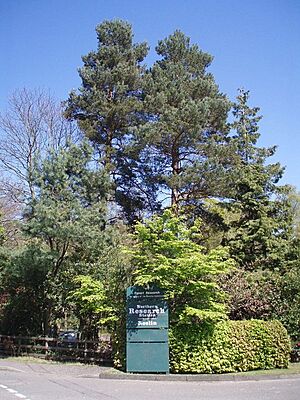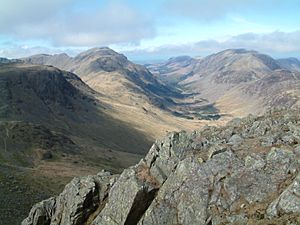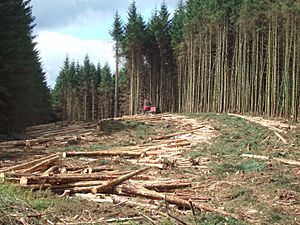Forestry Commission facts for kids
| Agency overview | |
|---|---|
| Formed | 1919 |
| Type | Non-ministerial government department |
| Jurisdiction | England (1919-present) Scotland (1919-2019) Wales (1919-2013) |
| Employees | 3,240 |
| Annual budget | £50.8 million (2009-2010) |
| Agency executive |
|
| Parent department |
|
| Child agencies |
|
The Forestry Commission is a special government group in England. Its main job is to look after forests owned by the public. It also helps manage and set rules for all forests, both public and private, across England.
The Forestry Commission used to be in charge of forests in Wales and Scotland too. But things changed! On April 1, 2013, the Welsh part joined other groups to become Natural Resources Wales. Then, on April 1, 2019, two new groups, Forestry and Land Scotland and Scottish Forestry, were created for Scotland.
The Forestry Commission started in 1919. This was after the First World War, when Britain's forests were very small. The Commission bought lots of land to plant new trees. It grew to become the biggest land manager in Britain. Today, the Forestry Commission has three main parts: Forestry England, the Forestry Commission itself, and Forest Research.
Over time, the Commission's work grew beyond just growing trees for wood. They now do many other things. This includes scientific research, often done in special research forests. They also encourage fun outdoor activities in forests. A big part of their job is also protecting and improving the variety of plants and animals in England's forests.
The Commission has faced some criticism. People sometimes worried about too many conifer trees, which can look very similar. There were also concerns about not enough different types of plants and animals. When the government tried to sell parts of the organization in 1993 and 2010, there were many public protests.
Contents
What Does the Forestry Commission Do?
Before Scotland got its own forest groups, the Forestry Commission managed a huge area. This was almost 700,000 hectares (about 1.7 million acres) of land in England and Scotland. This made it the biggest land manager in the country. Most of this land (70%) was in Scotland, with 30% in England.
The activities on this forest land include:
- Looking after and improving the natural environment.
- Providing places for people to enjoy outdoor fun.
- Harvesting timber (wood) for industries in the country.
- Planting new trees in areas that were once used for other things.
- Replanting areas where trees have been cut down.
The main reason the Commission started in 1919 was because of deforestation. Britain had only 5% of its original forests left. The government wanted to grow more trees for important resources. Since then, forest cover has doubled. The Commission's role has also grown to focus on managing forests in a way that helps them last. They also work to give the public as many benefits as possible.
Creating new woodlands is still a key part of the Commission's job. They work closely with the government to reach a goal of 12% forest cover by 2060. They support projects like The Big Tree Plant and the Woodland Carbon Code.
The Forestry Commission also sets rules for private forests in England. For example, it is usually against the law to cut down trees without a special permit from the Commission. They also encourage new private forests to grow. They do this by offering grants to help private forest owners.
How the Forestry Commission Started
| Forestry Act 1919 | |
|---|---|
| Act of Parliament | |

|
|
| Long title | An Act for establishing a Forestry Commission for the United Kingdom, and promoting afforestation and the production and supply of timber therein, and for purposes in connexion therewith. |
| Citation | 9 & 10 Geo. 5. c. 58 |
| Dates | |
| Royal assent | 19 August 1919 |
The Forestry Commission was created by the Forestry Act 1919. It started with eight forestry commissioners. Simon Fraser, 14th Lord Lovat was the first chairman from 1919 to 1927. The main goal was to increase woodland in Britain. They did this by buying land to plant new forests and replant old ones. They also wanted to help produce timber for trade.
In the 1920s, the Commission bought lots of land, often old farmland, to start new forests. During the Great Depression, the Commission's land continued to grow. By 1934, it owned over 360,000 hectares. Because land was cheap and more timber was needed, the Forestry Commission became Britain's largest landowner by 1939.
When the Second World War began, the Commission split into two parts. One part continued its usual duties. The other part focused on producing enough timber for the war. This split lasted until 1941. Much of the timber for the war came from places like the New Forest and the Forest of Dean. The war also led to a new system for licensing tree felling. By the end of the war, about a third of the available timber had been cut down.
After the war, the Commission greatly increased its research. They opened three research stations, starting with Alice Holt Lodge in 1946. This growth in research happened as timber sales also grew, reaching over £2 million per year in the 1950s.
The Countryside Act 1968 made public groups, including the Forestry Commission, think about protecting the beauty of the countryside. This meant the Commission had to focus on conservation and recreation, not just selling timber. People like Peter Garthwaite and Sylvia Crowe helped with this. Crowe also helped design forests to be better for people to visit and enjoy.
The Commission started building campsites in their forests in the early 1960s. In the 1970s, they created a special branch to build more cabins for public holidays. In 1970, they opened their Northern research station in Roslin. The 1970s also saw a report that questioned how profitable timber production was. There was also a major outbreak of Dutch elm disease.
In the early 1980s, the Forestry Commission started selling timber outside Britain. Exports quickly reached 500,000 tonnes per year. The Forestry Act 1981 allowed the sale of Commission land used for forestry. By 1986, some people wanted to sell off the entire Forestry Commission. However, the Wildlife and Countryside (Amendment) Act 1985 made the Commission balance timber production with conservation. The Great Storm of 1987 caused a lot of damage to forests, but most of the fallen trees were saved and sold.
In the early 1990s, the Forestry Department took over the Forest Authority. The management of the forest land became the job of Forest Enterprise. In 1993, there was another idea to sell off the Forestry Commission. This caused many protests from conservation groups. After a review in 1994, the government announced that "Forestry Commission woodlands will remain in the public sector."
Since the mid-1990s, timber sales have gone down. This made the Commission focus more on research and recreation. They also started to grow woodlands near towns and cities for the first time.
Because of devolution, the Forestry Commission had to report to the Scottish Parliament and Welsh Assembly, as well as the national government. This led to splitting responsibilities by country. Forestry Commission England, Scotland, and Wales became sub-departments. On April 1, 2013, Forestry Commission Wales joined Natural Resources Wales. Between then and April 2019, the Forestry Commission was only responsible for English and Scottish forests.
In October 2010, the government suggested selling or leasing public forests in England. This idea was met with strong public disapproval. Many people signed an online petition against the sale. In February 2011, after many protests, the government stopped its plans. An independent group was set up to advise on the future of forestry in England. This group suggested that the government had not fully considered the benefits of publicly owned forests.
From 2010, the Forestry Commission's budget was cut. This happened even though timber production and recreation use were strong. This led to some challenges for the organization.
Forestry Commission Wales (Welsh: Comisiwn Coedwigaeth Cymru) became separate on April 1, 2013. It joined other groups to form Natural Resources Wales. This was a big change, and some forestry officials worried about the industry's voice in the new group. On April 1, 2019, two new groups, Forestry and Land Scotland and Scottish Forestry, took over the Commission's jobs in Scotland.
Helping Communities
When the Forestry Commission was first planned in 1916, it had a wider goal. It wanted to help people in rural areas. Large parts of upland Britain were empty, and planting trees would make them more productive. It was thought that forests would bring more people to live in the countryside. Small farms would be near the forests, providing jobs for people working with trees. This would add new families to rural areas.
This idea guided the Commission for almost 50 years. In 1946, the Director General spoke about how the Commission created jobs. He said it helped solve the problem of getting people "back to the land." This was especially true with their policy of creating small farms.
Simon Fraser, 14th Lord Lovat, who helped start the Forestry Commission, had a lot of land in Scotland. He and other Scottish landowners thought of the idea of combining small farms with forestry. As the first chairman, he was able to make this dream of repopulating hill country happen across Britain. Money for this plan came from important government figures.
The plan went ahead, creating small farms of about ten acres in the new forests. These were rented for £15 a year. Originally, 150 days of work were provided in the forests. These small farms were very successful and met a real need in the countryside.
The building of small farms slowed down after the Great Depression. It was briefly restarted but then mostly ended by the Second World War. A total of 1,511 small farms were created. After 1945, the focus shifted to building houses without farms. This was more cost-effective for the Commission. By 1955, 2,688 cottages had been built. The small farm policy was good when only a few workers were needed for each forest. But as forests grew, more workers were needed. It became important to build new houses in villages or small communities. By 1958, the Commission owned 4,627 properties.
Many of the bigger forest villages were never finished. This was partly because they were isolated and due to money limits. Also, new machines and better transport meant fewer staff houses were needed. The idea of "company villages" in remote places was questioned.
Some houses were sold by 1972. The government encouraged selling off extra land and buildings. The sale of houses to new people increased a lot in 1978-79. Later, the government encouraged tenants to buy their homes with good discounts.
Even though the social policy of the Forestry Commission is in the past, it still has a big impact on upland areas. Many small villages and hamlets exist today because of the communities the Commission helped create.
How the Forestry Commission is Organized
The Forestry Commission is led by a Board of Commissioners. This board includes a chairperson and up to ten other Forestry Commissioners. The current chairman is Sir William Worsley. The Chief Executive, Richard Stanford, is also one of these commissioners. The King appoints the Forestry Commissioners. An Executive Board works with the Commissioners to manage the Forestry Commission's overall plans.
The Forestry Commission is divided into three main parts: Forest Services, Forestry England, and Forest Research.
In 2003, the way forests were managed was split between the three countries in Great Britain. Separate groups were then set up for Wales (Natural Resources Wales in 2013) and Scotland (Scottish Forestry and Forestry and Land Scotland in 2019). The Forestry Commission still reports to the Westminster Parliament through Defra ministers.
However, these different groups still work together on many things. Scottish Forestry manages the UK Forestry Standard and the Woodland Carbon Code. It also gives advice on forest economics. Natural Resources Wales used to coordinate forest research, but this job has now moved to Scottish Forestry. The Forestry Commission still helps coordinate international forest policies for the whole UK. It also handles certain tree health issues. Forest Research, which is a separate agency, continues to do research across the UK.
Forest Research
Forest Research is the scientific research part of the Forestry Commission. It does scientific studies and surveys. Its main jobs are to provide facts for British forestry policies. It also finds ways to manage forests in a sustainable way. It also works with other academic and business groups on research.
Forest Research has three main research stations. One is in each country of Great Britain. Alice Holt is in Hampshire, England. The Northern research station is in Scotland. A smaller unit is in Aberystwyth, Wales. Alice Holt was the first research station, started in 1946. It is the main one for Forest Research. The Northern research station in Midlothian opened in 1970. In 2009, the smaller unit in Aberystwyth was set up.
The Forest Research Technical Services Unit is based at the Northern Research Station. It has five field stations that do research for the Forestry Commission and other groups. This unit also looks after six smaller stations and the research station nurseries.
In 2006, Alice Holt forest became the first research forest in Britain. The Dyfi Catchment and Woodland Research Platform in Gwynedd followed in 2012. Alice Holt was chosen because the Commission had been doing research there since 1946. They had kept detailed records of the forest and its experiments.
Fun in the Forests
Before the Countryside Act 1968, the Forestry Commission mainly focused on selling timber. This act gave the public the right to use much of the forest land for fun. This led the Commission to add more facilities for visitors. Sylvia Crowe was hired to help make the forests better for recreation. This focus helped the Forestry Commission become the biggest provider of outdoor recreation in Britain.
The Commission works with groups interested in walking, cycling, and horse riding. They encourage people to use their land for these activities. A great example is the 7stanes project in southern Scotland. Here, seven special areas with man-made mountain bike trails were built. These trails also have easy-to-access parts for disabled cyclists. In the summer, the Commission hosts live music concerts in several forests.
Protecting Nature
Early forest plantings were criticized for not having enough variety of plants and animals. However, the Forestry Commission has been steadily improving its woodlands for wildlife. The large blocks of conifer trees planted early on were good for some animals. These included birds like the Eurasian siskin, goldcrest, and red crossbill. They also helped animals like roe deer and polecat. But now, the focus on more variety helps a much wider range of species. This includes broadleaved trees and open areas for different animals.
Our Forests
About 26% of the UK's woodland (0.86 million hectares) is managed by Forestry England, Forestry and Land Scotland, Natural Resources Wales, or the Northern Ireland Forest service.
When the Forestry Commission started in 1919, it took over several existing forests. Some of these were old royal forests with ancient woodland. Much of the land the Commission bought early on was heavily planted with conifer trees. Kielder Forest was one of these "new" forests, planted in 1926. It is now the largest forest in England and is managed by Forestry England.
The early use of mostly conifer trees, all the same age and very dark, led to criticism. People said the forests looked too artificial. The Commission was often given land with poor soil, usually in highland areas. Conifers were used because they can grow well in these tough conditions. By the 1960s, these trees were almost fully grown. The Forestry Commission received many complaints that their large, uniform forests were not attractive.
Since then, improving the look of forests has been a key part of the Forestry Commission's work. All forests have a Forest Design Plan. This plan aims to balance different goals. These include producing timber, making the landscape look better, restoring natural habitats, and providing recreation. Managing forests is a long-term job, with plans often lasting at least twenty-five or thirty years into the future.
See also
- The Big Tree Plant
- Confederation of Forest Industries
- Woodland Carbon Code
- Community Forests in England
- English Lowlands beech forests
- List of Forestry Commission land on the Isle of Wight
- List of forests managed by the Forestry Commission
- Scotland's Environmental and Rural Services of which Forestry Commission Scotland is a member
- International Year of Forests






